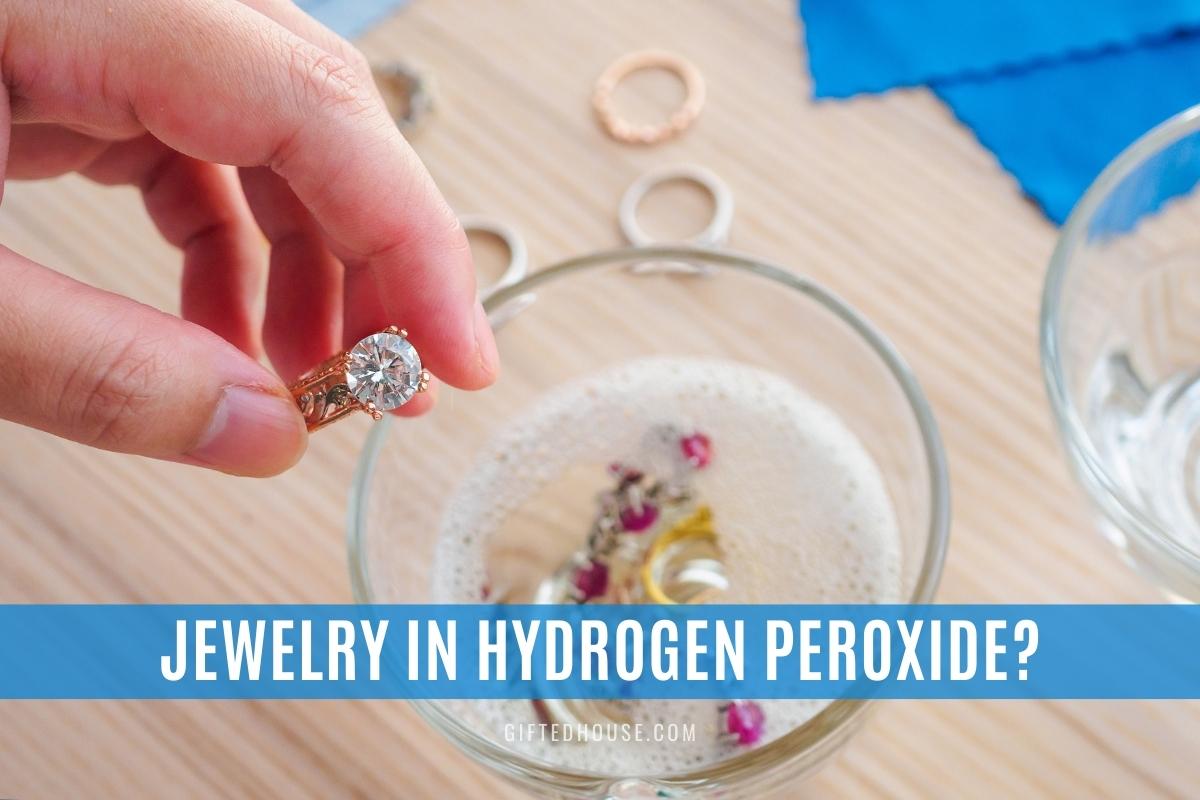Hydrogen peroxide is a widely used sterilizing and cleaning agent. Can you use it to clean jewelry, and if so, what types of jewelry? Will it damage the pieces?
Does Hydrogen Peroxide Damage Jewelry?
Hydrogen peroxide is a commonly used jewelry cleaner. While it is generally safe to use on metallic jewelry, it is not suitable for all types of jewelry.
Note that it is essential to follow some general guidelines when cleaning your jewelry with hydrogen peroxide. This chemical could damage even resilient materials when misused. These guidelines may change depending on the material your jewelry is made of.
When in doubt, use water to dilute the chemical, but be very careful when mixing it with other cleaning products. For example, you should never mix bleach with hydrogen peroxide.
This powerful oxidizing agent dissolves all the fatty build-up deposited on jewelry caused by sweat, food, and oils produced by your skin. It is incredibly effective at getting rid of dirt and sterilizing jewelry.
Hydrogen peroxide is also highly effective in killing bacteria, thus sterilizing your jewelry. This is useful when cleaning jewelry used in piercings.
Is it Safe on Gold Jewelry?
Yes, hydrogen peroxide is safe to use when cleaning gold jewelry. The best way to do this is to mix a mild detergent with water, then add a cup of vinegar and 1 or 2ml of hydrogen peroxide. It’s a potent oxidizing agent, so you don’t need much of it.
Leave the jewelry to soak in this solution for 10 to 15 minutes, then place them on a flat surface. Brush them using a soft-bristled brush (a toothbrush works well) to remove any residue and polish the surface. Rinse the jewelry with clean water and dry them.
White Gold
Hydrogen peroxide is safe to clean white gold and is used in the same way as regular yellow gold.
Silver Jewelry
Hydrogen peroxide effectively and gently cleans solid and plated silver when used correctly.
Suppose you increase the concentration of hydrogen peroxide in the cleaning solution. In that case, it could become too abrasive and damage the metal.
If you have plated jewelry, the effect of the damage will be even more significant since corrosion underneath plating tends to be worse than on external surfaces.
Diamond Rings
Hydrogen peroxide is safe to use on diamonds. The chemical will not harm the stone.
If your ring is made from gold, silver, or platinum, a solution of mild detergent, water, vinegar, and hydrogen peroxide will clean and sterilize it very effectively.
Fake Jewelry
Costume jewelry may not be as expensive as its gold or silver counterparts, but they also require regular maintenance.
If your costume jewelry is made of solid metal, such as stainless steel, cleaning it with a solution of hydrogen peroxide and baking soda will work well. As with the other types of jewelry, it is best to soak it in this solution for a while, then clean of any debris using a soft bristle brush.
How Long Can You Leave Jewelry in Hydrogen Peroxide?
The length of time you could leave jewelry or any other metallic objects to soak in hydrogen peroxide depends on the strength of the solution and the metal in question.
Typically, it is advisable to use a weak hydrogen peroxide solution (less than 3%) and not to soak your jewelry for more than 15 minutes. Some metals may react with hydrogen peroxide when exposed for extended lengths of time or when heated.
Can you leave it overnight?
Suppose your jewelry is severely stained and made of solid gold. In that case, you can leave it to soak in a mild hydrogen peroxide solution overnight.
If it’s made of silver, it’s best not to do this since the hydrogen peroxide may react with the metal, damaging your jewelry.
Why Do My Earrings Bubble in Hydrogen Peroxide?
During regular use, your earrings and other jewelry will likely pick up some bacteria from your skin. The number of bacteria would typically be greater on jewelry worn in piercings than on other types of jewelry. Bacteria and an enzyme called catalase, usually found in blood, act as catalysts to break down hydrogen peroxide. This reaction acts to kill bacteria, effectively sterilizing the jewelry.
Here, the hydrogen peroxide dissociates into water and oxygen, released as bubbles. So, when you see bubbles forming on jewelry soaking in hydrogen peroxide, it means that the chemical is working, killing bacteria and disinfecting your jewelry.
Note that hydrogen peroxide has a limited shelf life. Exposure to sunlight and enzymes catalyze the dissociation reaction, consuming all the hydrogen peroxide present in the 3% solution you would typically find in stores.
When you use hydrogen peroxide to sterilize or clean jewelry, and you don’t see any bubbles form, it probably means that the hydrogen peroxide has expired.

